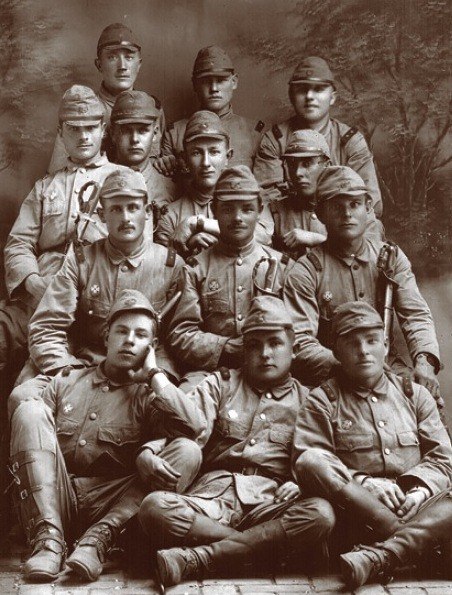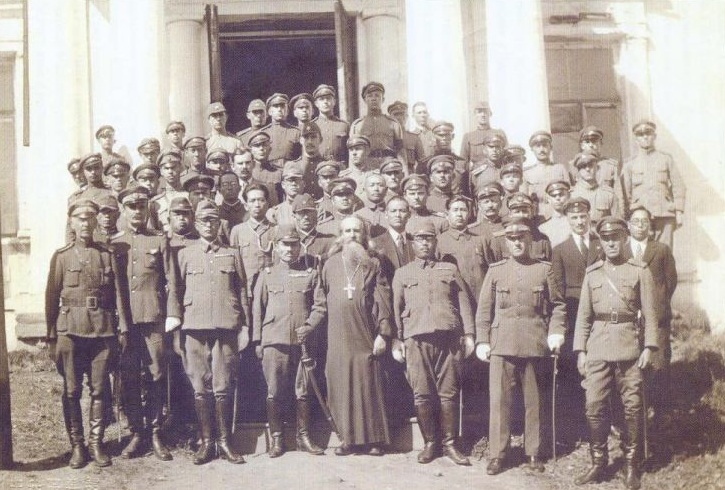Russians in the Service of the Japanese Emperor
- By Peter Harmsen
- 27 September, 2016
- 3 Comments
 Caucasians in Japanese-looking uniforms like the group in the photo to the left do not belong to the average type of World War Two imagery. In fact, the men in the picture are Russians. The background story is complicated and reflects the way the tumultuous first decades of the 20th century moved people across continents to lands far removed from their countries of birth.
Caucasians in Japanese-looking uniforms like the group in the photo to the left do not belong to the average type of World War Two imagery. In fact, the men in the picture are Russians. The background story is complicated and reflects the way the tumultuous first decades of the 20th century moved people across continents to lands far removed from their countries of birth.
Following Russia’s 1917 Bolshevik revolution and the ensuing civil war, tens of thousands of followers of the losing side ended up beyond the Russian empire’s eastern borders, mostly in Manchuria in what is now northeast China. Manchuria was a natural choice, since it had been the scene of considerable Sino-Russian economic exchange during the preceding decades.
Anti-Bolshevism and in many cases direct Fascism became important ideologies for these Russian emigres, who often were guided by an ambition to “retake” the Russia that had been lost to communism. Armed bands, frequently equipping themselves with Fascist symbols such as the swastika and the black shirt, emerged among the Russians. This provided the basis of a tenuous alliance with the Japanese empire, which was a growing political factor in Manchuria in the 1920s and early 1930s.
Once the Japanese had set up a puppet regime in Manchuria in 1932, naming it Manchukuo, some Russians ended up directly serving the interests of Japanese imperialism in northeast Asia. Some served in the Manchukuo Army, but the best known example was the Asano Detachment, a unit under the Kwantung Army, the main Japanese military force in northeast China.
Despite its name, alluding to its senior Japanese officer, Asano Takashi, the detachment was made up almost exclusively of Russians, albeit in Japanese uniforms. Its members wanted nothing more than fighting the communists who had usurped their homeland, and they did see action in some of the borders clashes between Japan and the Soviet Union in the late 1930s, but mostly they were unable to do as much as they wanted, and were limited to scattered acts of sabotage across the Soviet border.
The reason was simple: they were at cross-purposes with the Japanese Empire during almost the entire period until 1945. Japan’s military was deeply involved first in China and then in the Pacific, and the last thing it wanted was an additional front opening up against the Soviet Union in the north.
In the end of course, exactly that front opened up, to the detriment of Japan. In August 1945, the Soviet Union launched its massive attack against Japanese forces in north China and Korea, contributing decisively to the eventual defeat of the empire. The Russian units serving in Japanese uniforms made no difference whatsoever. Their leaders were captured by the advancing Soviet forces, and most were executed. It was an abrupt end of a weird chapter in Asian military history.




 Copyright © 2025
Copyright © 2025
The Russians serving in Japanese uniforms were known as the “Osa-no”. GB
That photo of Russians, more correctly White Russians, in Japanese Army uniforms is one rarely seen, and the history behind it not well known. I look forward to the possibility that Peter Harmsen rounds out his Shanghai 1937 and Nanking 1937 books to make it a trilogy with one on the WWII Japanese puppet state of Manchukuo. Apart from academic tomes and a Hollywood movie, there is not much published on Manchukuo for popular reading.
in my opinion, the Asano detachment was properly organized in pursuit of the plans of the Japanese invasion of Siberia “kantokuen” … and it is not surprising that, like them, the Japanese organized other groups such as the Isono / Matsuura Detachment (made up of Mongols del Mengchiang) or the Orochon detachment (consisting of Orochon monkeys) or Buriats units and the 39th cavalry unit (Chinese and other asian Muslims).,groups destined to operate in the Mongolian People’s Republic, Eastern Siberia and Central Asia within the Japanese plans
I do not see anything unusual about that, if the Germans had Ukrainian, Belarussian, Russian and other nationalities units before and during the Barbarossa operation, the German invasion of European Russia … I do not see why the Japanese could not organize similar groups to collaborate within his plans in Siberia ..
for example I can compare the detachment Asano with the special group of operations behind the Belarusian lines “Korny Kot” (Black cats) organized by the Germans during the last periods of Operation Barbarrossa, just as the Japanese group this airborne unit was created to sabotage and cause damage behind the enemy lines